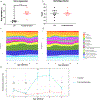Parabacteroides distasonis induces depressive-like behavior in a mouse model of Crohn's disease
- PMID: 34403735
- PMCID: PMC9217177
- DOI: 10.1016/j.bbi.2021.08.218
Parabacteroides distasonis induces depressive-like behavior in a mouse model of Crohn's disease
Abstract
Patients with inflammatory bowel disease (IBD) are particularly susceptible to behavioral diagnoses, and the microbiome has been repeatedly implicated in the pathogenesis of IBD. The intestinal microbiome's ability to affect behavior has become increasingly recognized and studied. The so-called 'psychobiome' has been linked to a plethora of neurological and psychological diagnoses, including autism and Parkinson's disease. Despite the ability of many bacterial species within the human intestinal microbiome to synthesize neurotransmitters, it has never been previously reported that a single bacterial species is sufficient to induce depression. Here, we demonstrate that our mouse model of Crohn's disease (CD)-like ileitis, the SAMP1/YitFc (SAMP1), does not exhibit baseline behavioral abnormalities. By comparison, SAMP6 mice develop depressive-like behavior that is associated with a rise in the GABA-producing bacterial genus Parabacteroides. We finally demonstrate that administration of Parabacteroides distasonis into our SAMP1 mice induces depressive-like behavior. Colonization with P. distasonis was not associated with increased intestinal inflammation or alterations in other measures of behavior. The intestinal environment of CD may be particularly conducive to colonization with P. distasonis and subsequent induction of depressive-like behavior. To our knowledge, this is the first report of a bacterial species specifically inducing depressive-like behavior.
Keywords: Crohn’s disease; Inflammatory bowel disease; Major depressive disorder; Microbiome; Microbiome-gut-brain axis; Parabacteroides distasonis; Psychobiome.
Copyright © 2021 Elsevier Inc. All rights reserved.
Figures



Similar articles
-
Human Gut Microbiome Transplantation in Ileitis Prone Mice: A Tool for the Functional Characterization of the Microbiota in Inflammatory Bowel Disease Patients.Inflamm Bowel Dis. 2020 Feb 11;26(3):347-359. doi: 10.1093/ibd/izz242. Inflamm Bowel Dis. 2020. PMID: 31750921 Free PMC article.
-
SAMP1/YitFc mouse strain: a spontaneous model of Crohn's disease-like ileitis.Inflamm Bowel Dis. 2011 Dec;17(12):2566-84. doi: 10.1002/ibd.21638. Epub 2011 May 6. Inflamm Bowel Dis. 2011. PMID: 21557393 Free PMC article. Review.
-
Akkermansia muciniphila and Parabacteroides distasonis synergistically protect from colitis by promoting ILC3 in the gut.mBio. 2024 Apr 10;15(4):e0007824. doi: 10.1128/mbio.00078-24. Epub 2024 Mar 12. mBio. 2024. PMID: 38470269 Free PMC article.
-
The Artificial Sweetener Splenda Promotes Gut Proteobacteria, Dysbiosis, and Myeloperoxidase Reactivity in Crohn's Disease-Like Ileitis.Inflamm Bowel Dis. 2018 Apr 23;24(5):1005-1020. doi: 10.1093/ibd/izy060. Inflamm Bowel Dis. 2018. PMID: 29554272 Free PMC article.
-
The TNF∆ARE Model of Crohn's Disease-like Ileitis.Inflamm Bowel Dis. 2024 Jan 5;30(1):132-145. doi: 10.1093/ibd/izad205. Inflamm Bowel Dis. 2024. PMID: 37756666 Review.
Cited by
-
A Prebiotic Diet Alters the Fecal Microbiome and Improves Sleep in Response to Sleep Disruption in Rats.Front Neurosci. 2022 May 24;16:889211. doi: 10.3389/fnins.2022.889211. eCollection 2022. Front Neurosci. 2022. PMID: 35685770 Free PMC article.
-
Chronic stress induces colonic tertiary lymphoid organ formation and protection against secondary injury through IL-23/IL-22 signaling.Proc Natl Acad Sci U S A. 2022 Oct 4;119(40):e2208160119. doi: 10.1073/pnas.2208160119. Epub 2022 Sep 26. Proc Natl Acad Sci U S A. 2022. PMID: 36161939 Free PMC article.
-
Chaihu-shugan-san alleviates depression-like behavior in mice exposed to chronic unpredictable stress by altering the gut microbiota and levels of the bile acids hyocholic acid and 7-ketoDCA.Front Pharmacol. 2022 Oct 19;13:1040591. doi: 10.3389/fphar.2022.1040591. eCollection 2022. Front Pharmacol. 2022. PMID: 36339629 Free PMC article.
-
Therapeutic potential of Parabacteroides distasonis in gastrointestinal and hepatic disease.MedComm (2020). 2024 Dec 16;5(12):e70017. doi: 10.1002/mco2.70017. eCollection 2024 Dec. MedComm (2020). 2024. PMID: 39687780 Free PMC article. Review.
-
Abnormal bile acid metabolism is an important feature of gut microbiota and fecal metabolites in patients with slow transit constipation.Front Cell Infect Microbiol. 2022 Jul 28;12:956528. doi: 10.3389/fcimb.2022.956528. eCollection 2022. Front Cell Infect Microbiol. 2022. PMID: 35967856 Free PMC article.
References
-
- Basson AR, Gomez-Nguyen A, Menghini P, Buttó LF, Di Martino L, Aladyshkina N, Osme A, LaSalla A, Fischer D, Ezeji JC, Erkkila HL, Brennan CJ, Lam M, Rodriguez-Palacios A, Cominelli F, 2019. Human Gut Microbiome Transplantation in Ileitis Prone Mice: A Tool for the Functional Characterization of the Microbiota in Inflammatory Bowel Disease Patients. Inflamm. Bowel Dis. 26, 347–359. 10.1093/ibd/izz242 - DOI - PMC - PubMed
Publication types
MeSH terms
Supplementary concepts
Grants and funding
LinkOut - more resources
Full Text Sources
Medical
Molecular Biology Databases

